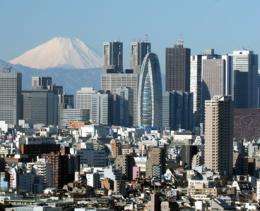The nuclear crisis and Japan's government

The response of Japan’s government to its multiple unfolding disasters has been better than its past performance in moments of crisis, but the country’s political leaders still have a long way to go to manage events well and win public confidence, MIT experts said in a public forum on Wednesday evening.
“As best as I can tell, people have been reasonably straightforward in revealing what is going on,” said Kenneth Oye, an associate professor of political science who was in Japan during Friday’s earthquake and for a few days afterward. However, he noted, in the past Japan has had “a culture and a system that has often valued secrecy and covered up problems,” which has proven problematic in significant ways relating to the current crisis.
While the ongoing problems with the Fukushima Daiichi nuclear power plant remain extremely serious, in its overall emergency response for people affected by Friday’s earthquake and subsequent tsunami, “the government has learned and benefitted from the mistakes of the past,” said Richard Samuels, Ford International Professor of Political Science at MIT and director of the Center for International Studies. Samuels noted that 100,000 troops have been mobilized for the larger relief effort.
However, as Samuels also remarked, “it remains to be seen if government will be up to the task.”
Moreover, while government and industry leaders have viewed nuclear power as a logical option in a “resource-poor” country, Samuels noted, numerous problems in recent decades, including an accident and management-ordered cover-up at one plant in 1999, have eroded public trust on the issue. “The public has been profoundly ambivalent about the introduction of nuclear power in Japan,” Samuels said.
Snapshot: Tokyo during the quake
At the event, part of the Starr Forum series hosted by the Center for International Studies, Oye gave his first-hand account of the Japan earthquake. He was scheduled to meet Japanese Prime Minister Naoto Kan on Friday at 6 p.m. local time, as part of a delegation from the U.S.-Japan Council. When the earthquake hit, a few hours before, Oye was sitting in a bus in a parking lot, not close to any potential hazards.
Right after the quake, on Friday in Tokyo, “people were calm,” Oye said, and over the weekend, “life was relatively normal.” But as the situation with the nuclear reactors worsened, by Monday “life was changing,” Oye observed, with rolling blackouts to preserve energy, and a large portion of Japan’s mass-transit networks closed. This has resulted in a “shutdown of the economy to a significant degree.”
“The level of cooperation in terms of responding to crisis was really quite remarkable,” said Oye, noting that villages in the north of Japan “self-organized” to obtain water and provide sanitation, demonstrating a great “cooperative spirit from below.”
The fact that Tokyo’s buildings survived the main earthquake and its many large aftershocks is a “testimony to the quality of building codes, the quality of engineering and the enforcement of those codes,” Oye said. However, he drew a distinction between the vigilance Japan has showed in the area of earthquake safety and the relative lack of stringency it has shown in the area of nuclear power. “The same country and the same political system which performed so beautifully in terms of seismic codes for buildings … is also the country which didn’t perform quite as well in terms of proactive responses” regarding power plants, he said.
One reason for this, Oye suggested, is that since earthquakes are a recurring phenomenon in Japan, they provided a lot of natural feedback for “a political system and a regulatory system that is designed to learn from experience.” By contrast, he said, the “lack of integrity and forthrightness” about Japan’s earlier nuclear incidents “led to bad policy-making and bad responses to the accidents. You don’t respond well when you’re lying, because you’re lying to yourself as well as to others. And that’s what happened in some of the earlier accidents."
Still, Oye said, “it is my view that things have improved,” a judgment made in part by extensively talking to officials and observers of the government before leaving Japan on Tuesday.
What’s next?
The next phase of government action will depend on events at the Fukushima Daiichi plant. Michael Golay, a professor of nuclear science and engineering at MIT, summarized the situation at the plants during Wednesday’s forum, in part reprising information shared at a Tuesday discussion at MIT.
Showing design drawings of the types of reactors at risk, Golay again emphasized the problems caused by the lack of power to the plant, which has led to major problems cooling the active fuel rods and spent fuel rods at Fukushima Daiichi.
“With any nuclear power plant today, if you lose power, you’re going to have this problem,” Golay said. “It’s not contingent on the exact hardware here.” Thus the notion that these reactors in Japan have had problems because they represent older technology “can be exaggerated.” Moreover, Golay said, “the time to get the grid restored has been much longer than you’d want.”
Due to the release of radiation from the reactors, an area of a radius about 12 miles around the plant has been evacuated, by order of the Japanese authorities, and those within 20 miles have been ordered to take shelter. Golay pointed out that if the situation dramatically worsened, however, an evacuation of Tokyo (with a metropolitan-area population of about 35 million lying roughly 130 miles away) was not a realistic scenario.
“Should there be a larger release of material … the primary option is going to be sheltering the public, and decontamination,” Golay said.
As Golay noted, however, the situation is ever-shifting, and it is not possible to draw definite conclusions based on limited information from afar.
“This story is not over,” concluded Golay.
This story is republished courtesy of MIT News (), a popular site that covers news about MIT research, innovation and teaching.
Provided by Massachusetts Institute of Technology
















